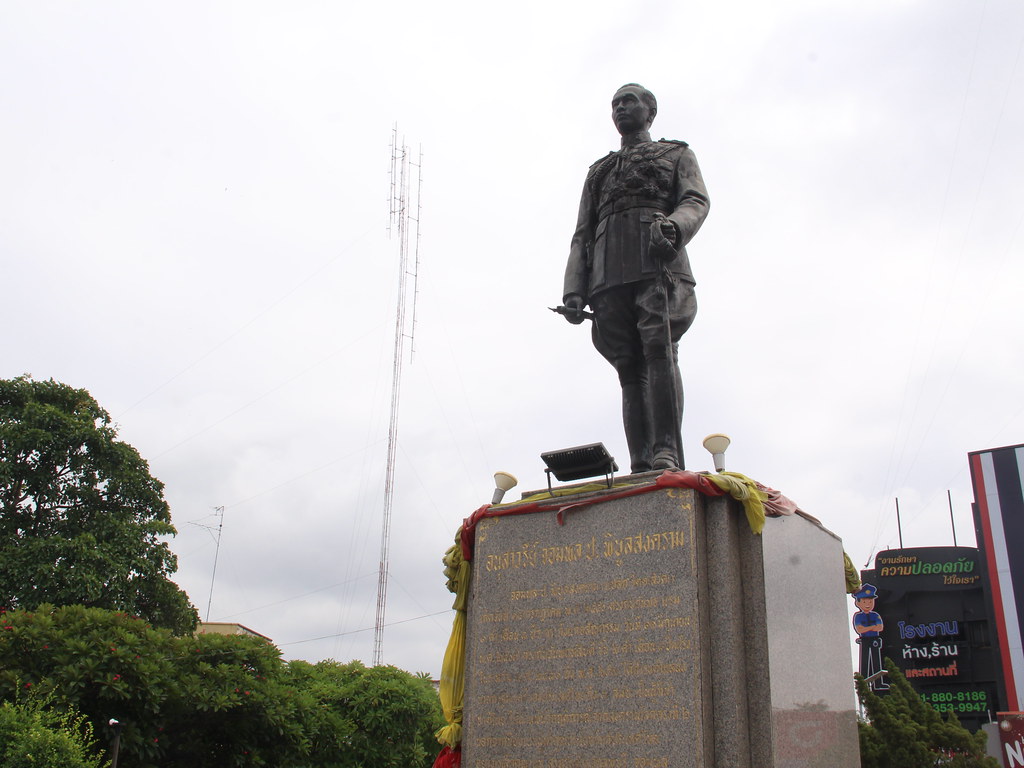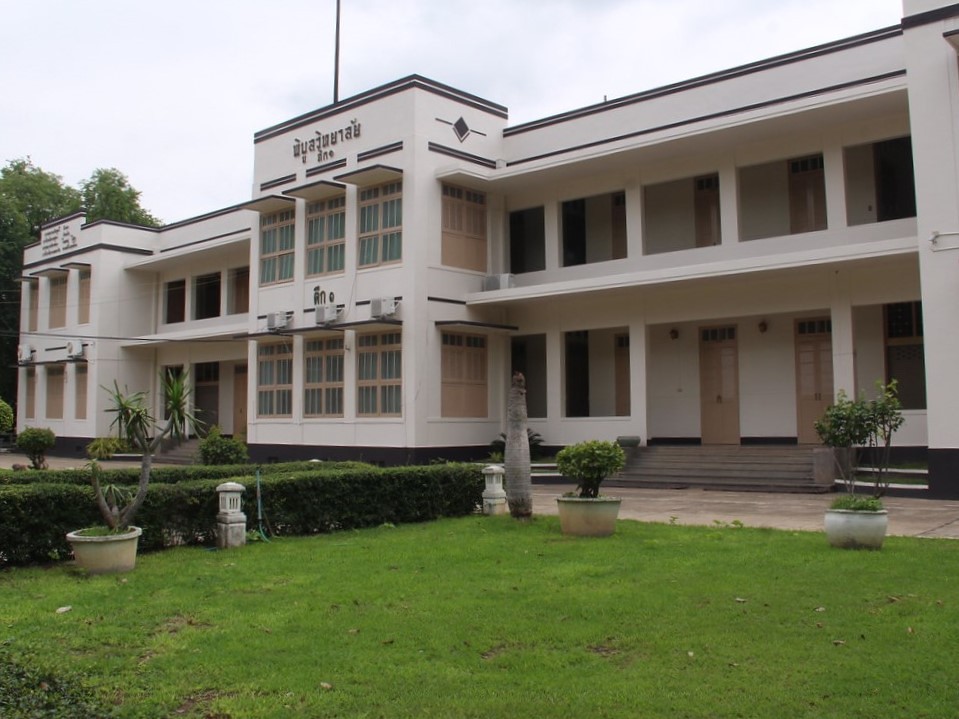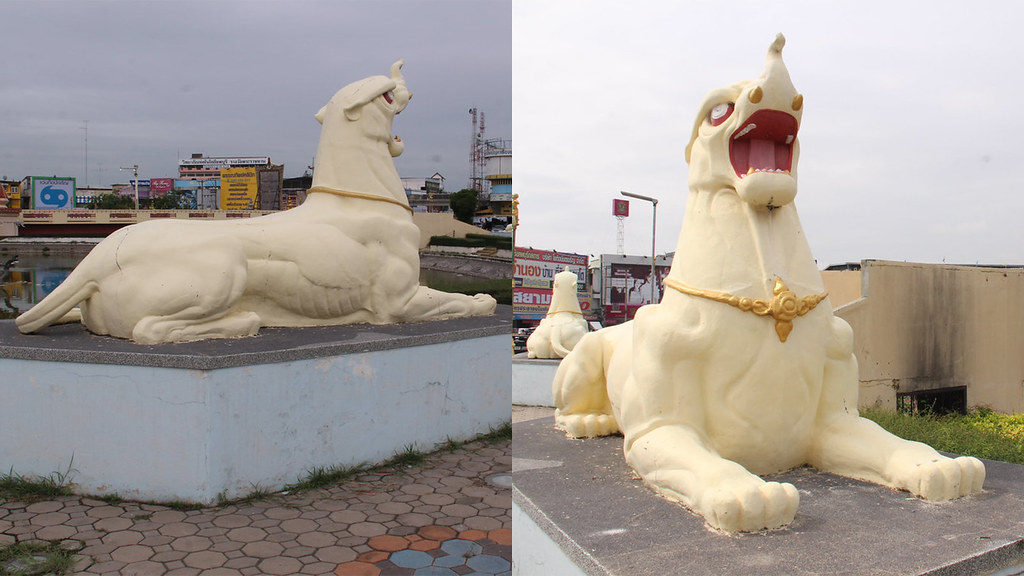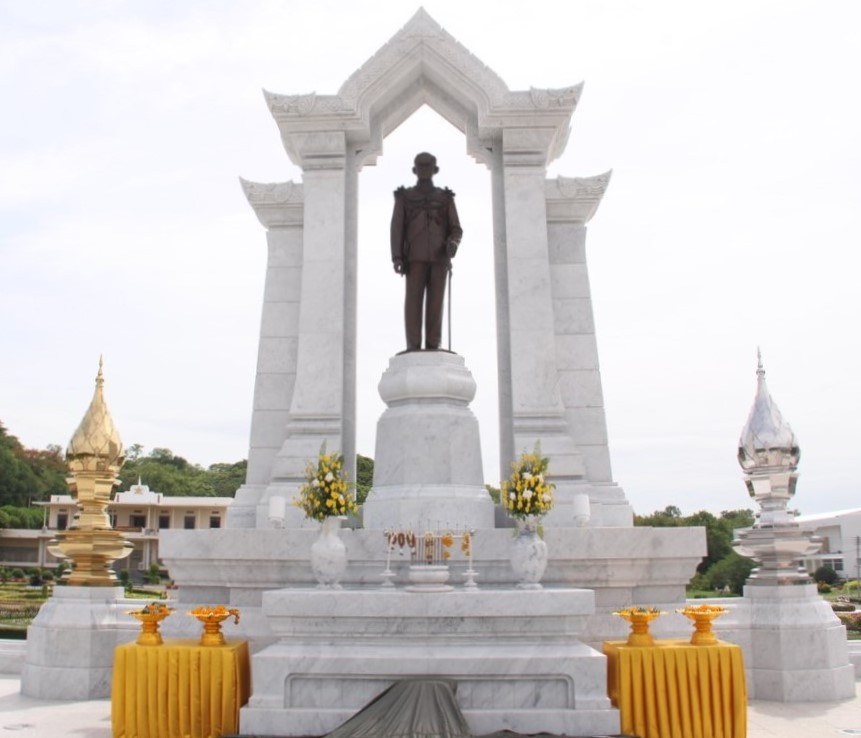From the demolition of the Constitution Defence Monument and removal of the Khana Ratsadon plaque in Bangkok to the demolition of the Phraya Phahonphonphayuhasena statue and the change of name of the Lopburi Artillery Centre in 2020, all were criticised as attempts to erase the history of Khana Ratsadon, the group that reformed Thailand from an absolute monarchy to a democracy.
Prachatai, together with Sarunyou Thepsongkraow and Sitthard Srikotr, two history experts from Kasetsart University (Bang Khen), explores the remaining architectural footprints of Khana Ratsadon that still remain in this city – and finds an answer as to why Khana Ratsadon during Field Marshal Plaek Phibunsongkhram's term considered Lopburi an important city, as well as the reason they chose Art Deco as a representation of their concept of ‘equality’.
From the City of Narai the Great to the City of Khana Ratsadon
The location of Lopburi has been important from Dvaravati times to the Ayutthaya Kingdom, especially during King Narai the Great’s reign, due to its geographical and communications significance, before becoming an important city once again in the early part of the Khana Ratsadon period.
The development of the new Lopburi was one of Khana Ratsadon’s projects. An important turning point was after the defeat of the Boworadet Rebellion at Bang Khen in 1933. In 1936, the government lead by Phraya Phahon, one of Khana Ratsadon’s core leaders, issued a Royal Decree on land expropriation in the east of Lopburi (all of the old city area to Khok Kathiam subdistrict) to use the area for military purposes.

Statesman Monument, Sa Kaeo Roundabout, taken in 2022, one of the important roundabouts in the Khana Ratsadon era, located in Lopburi’s new city zone
Phibun, then a major and Minister of Defence, planned to benefit from the area by developing the land into a new city and turning it into a military zone. Many military units were relocated from Bangkok to Lopburi.
The construction of the Lopburi new city started in 1937. Then on 24 Jun 1940, Thailand’s national day, then-Prime Minister Phibun himself presided over the Lopburi new city opening ceremony, which was also the same day as the opening of the Democracy Monument. He attended the Monument opening ceremony in the morning, then drove to attend the Lopburi new city opening ceremony in the evening.
2 factors why Khana Ratsadon chose Lopburi
Chatri Prakitnonthakan, lecturer at the Faculty of Architecture, Silpakorn University, has analysed two important reasons why Field Marshal Phibun chose to develop this City of King Narai. First is the personal bond between two Khana Ratsadon leaders and Lopburi, since both Phraya Phahon and Phibun were stationed at the Lopburi Artillery Centre before going to study abroad. They returned to lead the revolution in 1932.
The other reason is military strategy. Sitthard added that during the Khana Ratsadon era, Lopburi’s importance was levelled up a notch. Field Marshal Phibun wanted it to be a military city or the centre of the military community to protect the area and deal with enemies during World War II.
In addition, in 1937 Field Marshal Phibun had planned to move the capital from Bangkok to Lopburi, but the plan was shelved and Phetchabun was considered instead for reasons of military geography, since Phetchabun can be better protected from invasion by infantry.

Field Marshal Plaek Phibunsongkhram Monument at Sa Kaeo roundabout
However, in 1944 the ‘Chicken Symbol[1] Field Marshal’ had to step down from the position of the nation’s leader before his dream of changing the capital came to fruition, after he lost the parliamentary vote on the Phetchabun Government Management Bill and Phutthaburi Province Construction Bill on 20 and 22 Sep 1944. As a result, the idea of turning Lopburi into a military city disappeared along with the authority of Field Marshal Phibun.
Although Field Marshal Phibun no longer had power, the idea of developing a new Lopburi city during the Khana Ratsadon era had plastered the city with the aura of the-era’s architectural style known as Art Deco, chosen by Khana Ratsadon to represent their political ideology– of equality.
“In 1937, Field Marshal Phibun proposed to move the capital from Bangkok to Lopburi and develop it into a new city; new art was introduced, resulting in Lopburi becoming one of the cities with the most Khana Ratsadon art in Thailand, compared to other provinces,” Sarunyou said.
Get to know Art Deco, the art representing Khana Ratsadon
History lecturer Sitthard Srikotr said that Art Deco architecture developed after WWI. Its features are a rejection of the earlier focus on building decoration, and an attempt to make art serve humans ‘honestly’. It was also known in France as ‘Art Nouveau’ or in Germany as ‘Jugendstil’.
“Buildings shouldn’t be that elegant or dandified. When fancy decoration became too much, at that time they tried to say that decoration should focus on simplicity, by returning back to geometry,” Sitthard said, and added that this art entered Thailand during the reigns of Rama V and VI, but at that time the elite were not yet that much into art.
One piece of evidence which reflects this well is the planned Art Nouveau-style Hua Lamphong Station which was not built. The plan still allowed for decoration but mostly in geometric shapes, perhaps almost 80%. In the end, the Thai elite chose the design of Mario Tamagno, an Italian architect, which looked more elegant and ornamental.
The announcement of a new political system reflecting ‘equality’
After the Siam revolution in 1932, Art Deco was brought back to Siam by Khana Ratsadon. Sarunyou revealed that primary sources indicated that Khana Ratsadon called these buildings ‘Modern Buildings’. The Art Deco buildings are designed with smooth geometrical lines, density and many apertures for light.
Such features can be found in, for example, the buildings along Ratchadamnoen Avenue, Bang Rak Central Post Office, the Court of Justice building, as well as buildings in Lopburi such as Pibulwitthayalai School, Ananda Mahidol Hospital, Thepsatri Rajabhat University, the Royal Thai Army Cinema, etc. These buildings used reinforced concrete which allows quick and easy construction.
Art Deco architecture originally started in 1920-1930. The main objective was to design schools or factories, for example, focusing mainly on their uses. So they were built as easy squares with open channels for light to flow in to allow people to work or hold activities. Roofs are straight cut and flat with no decorations, giving a feeling of stability, but smooth strength.

Pibulwitthayalai School built in 1937-1938. Its distinctive features are the large awnings over the windows which show the builder’s skills.
This architecture was popular in many countries; each nation chose Art Deco to display the political ideologies of the elite in various forms. Japan, Italy and Germany, for example, used Art Deco to represent fascism while the Soviet Union used Art Deco to promote class consciousness in communism.
For Thailand, Khana Ratsadon chose Art Deco to support the ideology of ‘equality’ while Sitthard added that Khana Ratsadon may have chosen it partly because of the worldwide trend toward Art Deco architecture.
“Other than being the architectural choice of Khana Ratsadon, Art Deco was the trend of architecture during that era as well. … The significance is that the people of that era viewed it as the architecture of a modern world. If you say ‘I’m a new system, I’m not the old world, old system, the absolute monarchy’, then this kind of art, this kind of building, was chosen to be the architectural representation of what was Khana Ratsadon’s mega project,” Sitthard said.
There was previously an interpretation that Khana Ratsadon chose this architectural style since they wanted the people to feel stable during times of instability, since they were in the middle of World War II, but Sitthard said that it is uncertain whether Khana Ratsadon had intended for it to be used in this way or not.

Dentistry building or submarine building, Ananda Mahidol Hospital. Its distinctive features are the many transparent glass windows on the second floor.
Sarunyou added that sculptures by Khana Ratsason are no less distinctive than their architecture. The sculptures of that time focused on a clear muscular and realistic anatomy, different from the effeminate art, far from reality, during the traditional era.
An important example of Khana Ratsadon’s sculpture in Lopburi is the gajasimha around the Sa Kaeo roundabout, the sculpture of a dancer near the Phibun Monument in front of the Army Cinema or the crouching tiger sculpture in front of the Lopburi Zoo.
“With strong muscles, the gajasiha (symbol of the Ministry of Defence) is a lion, not delicate like gajasihas in the Himmapan (Himavanta) Forest, with elephants’ trunks,” Sarunyou said.

Gajasiha sculptures at the Sa Kaeo roundabout in 2022

By comparison, the gajasiha in front of the Ministry of Defence (Source: Facebook Fanpage Defence Hall Museum)
Another culture born during the time of Khana Ratsadon is the practice of erecting flagpoles for the national flag in front of government buildings. Sitthard revealed that there were some previously, but it was not compulsory for all government buildings to have one. After the revolution, especially during nationalistic periods, Field Marshal Phibun tried to turn the flagpoles into city landmarks as symbols glorifying nationhood.
“The flagpoles weren’t flagpoles where they simply erected a wooden or metal pole, ran up a flag, done. The bases had patterns in Art Deco style,” Sitthard said.
The same history lecturer from Kasetsart University provided as an example the flagpole at Thepsatri Rajabhat University. If we examine the base of the pole, we will see patterns in Art Deco style with the use of straight lines cut with curved lines so that it appears soft and delicate, not hard, creating a visual dimension and promoting modernity.

Thepsatri Rajabhat University’s flagpole
Applied Khana Ratsadon art, returning the roof
Sarunyou said that many Khana Ratsadon buildings have straight-cut flat roofs. In actuality, they aren’t rooftops, but the walls were built to hide the roof, so it looks flat. These buildings can be found on Ratchadamnoen Avenue. This is partly because there was a law during the Khana Ratsadon era stipulating that roadside commercial buildings had to raise their walls to hide their roofs. This reflected the ‘new spirit’ which they wanted to make more public.
Sitthard said that the issue was the roof because it is a distinctive feature of ancient Thai traditional architecture, a symbol of inequality in architecture. At first Khana Ratsadon was going to accept the full Art Deco style, but contradictions arose when we entered the era of Field Marshal Phibun who was a fascist. In 1942, people asked, if we accept everything international, then where is being ourselves? When they thought like that, they started to return to roofs at an acceptable level.
“Art Deco is international, but if we are going to use it, our own identity can add to what is international, so gable roofs and Art Deco forms of gable edges returned,” Sitthard said.

Example of Art Deco corbels at Wat Phra Phutthabat, Saraburi. Chatri says that this design came from the book ‘Buddhist Architectural Art, Part One.’ In the picture are corbels which support protruding parts of the roof. The one on the right is traditional but the one on the left was built from reinforced concrete in Art Deco style – there is less ornamentation, and a cleaner, more geometric form.
Khana Ratsadon’s legacy which disappeared from the Lopburi Artillery Centre
Another location which hides many Khana Ratsadon legacies is the Artillery Centre, Lopburi, whether it is the Chateau Building or the Nam Chon Mountain Command Building, the residences of Phraya Phahon Phonphayuhasena and Phibun, and both of their monuments.
BBC Thai interviewed Chatri who said that actually, Field Marshal Phibun’s monuments, which are found across Thailand, are not connected to Khana Ratsadon, but more to the Chicken Symbol Field Marshal as a soldier of the army and former Prime Minister, who brought prosperity to the nation.
The Centre was built during the Absolute Monarchy in the course of Prince Boworadet’s term as Deputy Minister. The Ministry of Defence established the Lopburi Artillery Centre in Khok Kathiam Subdistrict in about 1914, and it continued to develop until the time of Khana Ratsadon, especially under Field Marshal Phibun when it received more attention since the Field Marshal wanted to develop artillery units to prevent enemies from invading the new capital city, which in this case was Phetchabun.
However, during King Rama X’s reign in 2019, the legacies of Khana Ratsadon inside the Artillery Centre slowly started to disappear. Starting in 2020, the Royal Government Gazette website published a change of name of the Artillery Centre in Khao Phra Gnam Subdistrict, Mueang District, Lopburi Province from ‘Fort Phaholyothin’ into ‘Fort Bhumibol’, while the Artillery Brigade Camp originally named ‘Fort Phibunsongkhram’ located at Tha Khae Subdistrict, Mueang District, Lopburi, was changed to ‘Fort Sirikit’.
In addition, the monuments to Phraya Phahon and Phibun at the gates of the original Fort Phaholyothin were removed in 2020. The Phraya Phahon monument was replaced with a monument of King Rama IX. An inauguration ceremony for the monument was carried out in 2022.

King Rama IX Monument at the Artillery Centre, Lopburi
A 2022 survey of the Artillery Centre found that the residences of Phraya Phahon and Phibun and the Chateau Building were still in existence.
However, our journalist’s survey in 2022 found Chateau Building in a dilapidated condition, especially the left side which has broken down, showing the inner structure built from reinforced concrete and stone, materials commonly used for building construction during Khana Ratsadon times.
‘Erasing’ does not help to forget, but may help to ‘remember’
No one knows the reasons behind the change of names of the military camps or the removal of the monuments to the two Khana Ratsadon leaders. Chatri observed that it may be because from 2006 onwards, academics, students, historians and political activists all used symbols, locations or legacies of Khana Ratsadon as part of their political movements.
At the same time, in the new generation’s political protests from 2020 onwards - which were started by REDEM – the Democracy Monument, another of Khana Ratsadon’s legacies, was used for political protests so frequently it almost became a norm.
In addition, the new generation created cultural copies related to Khana Ratsadon. For example, a symbolic installation ceremony was held on the morning of 20 Sep 2020 for a replica Khana Ratsadon plaque at Sanam Luang during the #19Sep protest, calling for the people’s authority to be returned. The protest then spread to Chiang Mai and Nakhon Ratchasima. Various souvenirs were created, such as Khana Ratsadon plaque cookies, Khana Ratsadon plaque keyrings, etc. These examples show how the new generation values Khana Ratsadon as the group that paved the way for democracy in Thailand.

The gate of Artillery Centre, Lopburi, demolished
When we asked Ajarn Sarunyou about the attempts to erase the memory of Khana Ratsadon over the past 3 years, the expert on Khana Ratsadon history views that erasing may only be possible for a certain time, but history cannot be changed, and it may instead result in many people trying to do more to record and remember this history .
“It may make people forget for a time, but it cannot change the past. There is a lot of evidence that cannot be removed. … One fine day they are removed, and it makes people want to look again, and go back and remember it again,” Sarunyou said.
[1][Translator’s note] The chicken or rooster was the symbol of Phibunsongkhram Province, an area which was temporarily annexed by Field Marshal Phibun during World War 2 from French-occupied Cambodia. The area was returned to the French colonial authorities after the end of the war.
Prachatai English is an independent, non-profit news outlet committed to covering underreported issues in Thailand, especially about democratization and human rights, despite pressure from the authorities. Your support will ensure that we stay a professional media source and be able to meet the challenges and deliver in-depth reporting.
• Simple steps to support Prachatai English
1. Bank transfer to account “โครงการหนังสือพิมพ์อินเทอร์เน็ต ประชาไท” or “Prachatai Online Newspaper” 091-0-21689-4, Krungthai Bank
2. Or, Transfer money via Paypal, to e-mail address: [email protected], please leave a comment on the transaction as “For Prachatai English”
